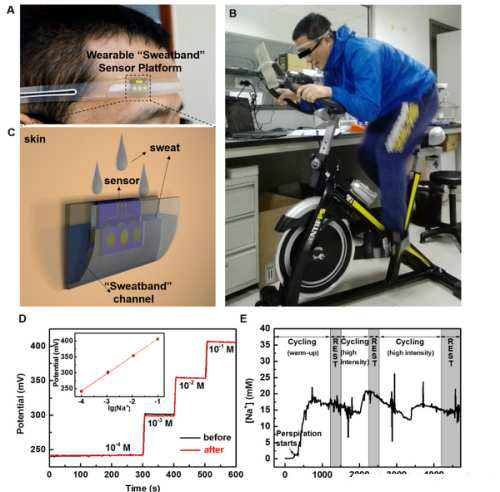[Chinese instrument network instrument research and development] Human sweat is rich in a large number of potential health and disease-related markers, compared with conventional blood and urine tests, it has non-invasive (Non-invasive) and real-time continuous monitoring and other advantages, Therefore, the research of wearable sweat sensors has become one of the focuses of the development of wearable healthy electronic devices.

(A), (B) and (C) are photographs and schematic diagrams of a wearable “sweat strip†sweat sensor device; (D) calibration curves of sweat sensor chips before and after wearing on different concentrations of standard Na+ solution; ( E) A graph showing the change of Na+ concentration in sweat in real time during the movement of the sweat sensor on the human body.
The miniaturized, integrated all-solid-state ion selective electrode and all-solid-state reference electrode are core sensing technologies for detecting electrolyte ion concentration in sweat. However, most existing solid-state ion sensors mostly use conductive polymers as ion/electron conductive layer materials, which have the disadvantages of poor stability, many interference factors, short service life, and the like, which limits their application in the field of wearable sweat detection.
The Zhang Yan research team of the Suzhou Institute of Nanotechnology and Nano-Bionics of the Chinese Academy of Sciences had previously developed a flexible wearable ion-based humidity sensor (Advanced Science, 2017, 1600404, 1-7, Back Cover) that can be used for skin moisture detection. Further, for key scientific and technical issues such as the miniaturized all-solid-state ion sensor and the stability of the all-solid-state reference electrode, the research team designed and fabricated an electrode chip with a microwell array as a template in combination with MEMS micro-nano processing technology, and prepared it by one-step electrodeposition. A large specific surface area and tunable three-dimensional gold nanostructure ion/electron conduction array electrode, compared with an ion/electron conductive layer based on carbon nanotubes, graphene, porous carbon, etc., has advantages of simple preparation, good repeatability, and the like . The all-solid-state ion selective electrode constructed by the electrode chip has stable potential response sensitivity (56.58 ± 1.02 mV/decade), fast response time (<10s) and wide linear range (10-6 to 10-1 mol/L) The sensor's potential drift and water layer interference effects are reduced. By optimizing the composition of the reference electrode polymer membrane and salt, an all-solid-state reference electrode based on a polymer/potassium chloride is integrated on the sensor chip, and the miniaturized reference electrode chip obtained has a short equilibration time and a different type. With different ionic strengths, the electrolyte has less interference, is insensitive to light, has a stable response in the pH range of 3 to 10, and has long-term stability and other advantages.
At the same time, the research team innovatively designed wearable “sweat guide†sweat sensor devices with sweat collection, transfer, and discharge structures, and integrated the sensor chip with the sweat sweat guide belt to comfortably and conveniently wear the forehead area of ​​the human body. It can monitor and monitor the electrolyte ions in real time continuously in the course of human body movements, and monitor the dehydration conditions of people during fitness exercise, especially for athletes, emergency rescue personnel, and military personnel with early warning during the implementation of high-intensity tasks. And guiding significance. Related research results were published in Analytical Chemistry.
This work was supported by the National Natural Science Foundation of China, the Outstanding Youth Fund of Jiangsu Province, and the China Postdoctoral Science Fund Project.
(Original Title: Research progress on wearable sweat sensor research for Suzhou Nano Institute)